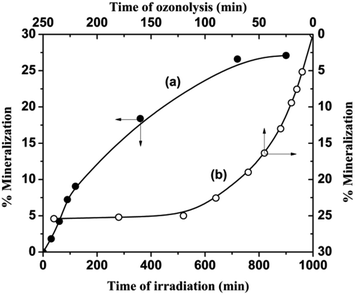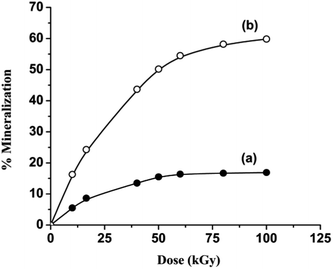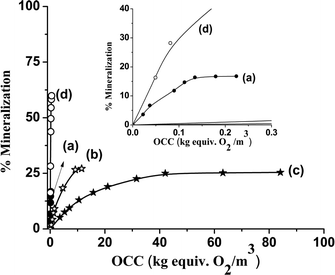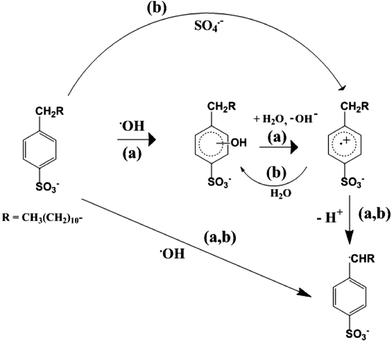An insight into the effective advanced oxidation process for treatment of simulated textile dye waste water
Jhimli Paul Guin*a,
D. B. Naikb,
Y. K. Bhardwaja and
Lalit Varshneya
aRadiation Technology Development Division, Bhabha Atomic Research Centre, Trombay, Mumbai-400 085, India. E-mail: paul.jhimli@gmail.com; Fax: +91-22-2550-5151; Tel: +91-22-2559-0175
bRadiation and Photochemistry Division, Bhabha Atomic Research Centre, Trombay, Mumbai-400 085, India
First published on 19th August 2014
Abstract
The efficiencies of the advanced oxidation processes (AOP) viz. photocatalysis, ozonolysis and gamma radiolysis in the absence and presence of potassium persulfate (K2S2O8) were systematically investigated for the treatment of simulated textile dye waste water (STDWW) containing Reactive Red 120. The oxygen-equivalent chemical-oxidation capacities of photocatalysis, ozonolysis and gamma radiolysis in the absence and presence of K2S2O8 for 16% mineralization of STDWW were calculated as 4.02, 16.19, 0.13, 0.05 kg equiv. O2 m−3, respectively. The gamma radiolysis in the presence of K2S2O8 showed the maximum extent of mineralization among these three AOPs. The pulse radiolysis studies revealed that the favourable reaction of SO4˙− with SDBS (the most robust organic component of STDWW) producing benzyl and hydroxycyclohexadienyl type of radicals caused the enhancement in the extent of mineralization of STDWW during gamma radiolysis in the presence of K2S2O8. The COD of the STDWW was brought down to 1558 ppm from 3128 ppm by gamma radiolysis at 50 kGy dose in the presence of K2S2O8; though that index could not meet the allowed discharge limit (COD ≤ 250 ppm) of industrial effluent in the main water stream. Conversely, on replacing organic acid (CH3COOH) by inorganic acid (H2SO4) in the pH adjustment step, COD of STDWW was brought down to 245 ppm by gamma radiolysis at 60 kGy in the presence of K2S2O8. This paper recommends using H2SO4 in place of CH3COOH in the pH adjustment step followed by the gamma radiolysis of STDWW in the presence of K2S2O8 for an effective effluent treatment.
1. Introduction
The textile industries are vital to the Indian economy as textile represents more than 10% of the country's exports. The textile effluents are a threat to the ecosystem from two perspectives; firstly, the bio-resistant synthetic dye molecules implement intense colour to water even at very low concentrations. Secondly, the auxiliary chemicals (i.e., surfactants, sequestering agent, pH-adjusting acids, inorganic salts etc.) of the dye bath contribute to ∼83% of the organic load of the effluent.1,2 The heavy organic load of the textile effluent causes a negative impact to the aquatic lives owing to the decrease in the dissolved oxygen concentration in the water stream.3 The chemical oxygen demand (COD), which is a measure of the organic load of the effluent, varies in the ranges 2900–3000 ppm in the textile effluents. Since it is well above the permissible discharge limit (COD ≤ 250 ppm) set by the Central Pollution Control Board under the Ministry of Environment and Forest, Government of India, the development of an effective and efficient treatment process for textile effluents is necessitated.The synthetic reactive azo dyes are mostly being used in the textile industries,4 but those are non-reusable because of their hydrolysis in the alkaline dye bath solution. The physicochemical treatments, such as precipitation, coagulation, reverse osmosis, electrolysis and adsorption are being used in the conventional dye effluent treatment plants.5 However, the large amount of sludge or secondary waste generation as well as the resistance of the reactive dyes to photo- or bio- or chemical-degradation are the major disadvantages of physicochemical treatment processes.6
The advanced oxidation processes (AOPs) are emerging out for the efficient oxidative mineralization of organic compounds in addition to minimizing the productions of sludge, secondary waste and toxic intermediates.7 The fenton, photocatalysis, sonolysis and ozonolysis are well studied AOPs, but suffer from their own limitations.7–12 Radiolysis using high energy ionizing radiation is upcoming as one of the promising AOPs for the degradation of varieties of dyes and organic pollutants in aqueous solution. Decolouration and mineralization of pure Reactive Red-120 (RR-120) dye using high energy radiation (gamma and electron beam) was recently reported by us.13,14 The results showed satisfactory mineralization of RR-120 on irradiation to a dose of 10 kGy. However, the recalcitrant nature of the auxiliary organic components of textile dye bath solution demands a validation of the process efficiencies of a couple of AOPs for the mineralization of simulated textile dye waste water (STDWW), mimicking the compositions used in dye industries.
In the present study, three AOPs viz. photocatalysis, ozonolysis and gamma radiolysis were employed to evaluate the process efficiency of mineralization of STDWW. The pulse radiolysis studies were employed to understand the mineralization of SDBS (the most robust organic component of STDWW) by SO4˙−. The oxygen-equivalent chemical-oxidation capacities (OCCs) of these AOPs were also evaluated to support the observed trends in mineralization. This is the first report, to the best of our knowledge; on the determination of OCC of photocatalysis and gamma radiolysis. The effects of different additives, neutralising acids and the change in pH of STDWW during the mineralization process were also investigated.
2. Experimental
2.1 Dye and chemicals
RR-120, sodium dodecylbenzenesulfonate (SDBS), sodium dodecyl sulfate (SDS), ethylenediaminetetraacetic acid (EDTA), K2S2O8, tert-butanol were purchased from Sigma-Aldrich. The titanium dioxide (TiO2) (Degussa (P25), particle size ∼ 30 nm) was used as photocatalyst. All other chemicals used were of the highest purity and used without any pretreatment.2.2 Preparation of STDWW
The components of the dye bath and the role of each constituent in the dyeing process are summarized in Table 1. The hydrolyzed dye effluent was prepared by boiling the constituents with 1 M NaOH at 80–90 °C for 3 h under reflux.15 The characteristic of the hydrolysed dye effluent before the treatment process is given in Table 1.| Component | Concentration (mg L−1) | Function |
|---|---|---|
| C.I. Reactive Red 120 | 70 | Colouring agent |
| Sodium dodecylbenzenesulfonate (SDBS) | 375 | Detergent used for washing excess dye |
| Ethylenediaminetetraacetic acid (EDTA) | 150 | Removal of unwanted metal ions in the dye bath |
| Na2CO3 | 4876 | Adjustment of the starting pH (8.8–9.3) |
| NaOH | 188 | Adjustment of the final dyeing pH (10.5–11.0) |
| NaCl | 1.5 × 104 | Promotes dye binding onto cotton |
| Acetic acid | As required | For pH (10) adjustment |
2.3 Instruments and analytical procedures
Steady state radiolysis of STDWW solution was carried out at different doses using 60Co gamma radiation with a dose rate of 2.0 kGy h−1. The dose rate of the gamma source was determined by using Fricke dosimetry [G(Fe3+) = 15.6/100 eV]. The photocatalytic experiments were carried out by using Rayonet Photochemical Reactor. The light source contains 16 mercury lamps of 8 W power each and emitting in the near-UV (mainly around 350 nm) having photon flux (I0) of 5.0 × 1015 photons cm−2 s−1. The volume and area of the cell is V (cm3) and A (cm2), respectively. Ozone was continuously produced from pure oxygen by UOS04 model ozone generator and bubbled into the aqueous solution of STDWW. The ozone generator can produce 4 g h−1 ozone from pure oxygen feed where oxygen flow rate was maintained as 2 L min−1. The input rate of ozone from the ozone generator into the aqueous solution was determined as 7.3 × 10−3 mol dm−3 min−1 by the standard iodometric method. Pulse radiolysis (PR) experiments were performed by optical detection measurement with 7 MeV linear electron accelerator with pulse duration of 500 ns. Dose per pulse was measured using aerated aqueous solution of thiocyanate taking (Gε) = 2.6 × 10−4 m2 J−1 at 475 nm.16 Decolouration, COD and pH of the solutions were measured by using U-2800 spectrophotometer, Spectroquant® Pharo 300 COD analyser and pH meter 600, respectively.3. Results and discussion
3.1 Decolouration and mineralization of STDWW by photocatalysis and ozonolysis
The hydroxyl radical, ˙OH, which is a strong oxidising agent, is generated from the surface of TiO2 particles upon irradiating with UV light. The photocatalytic treatment of STDWW was carried out for different time intervals. It took about 500 min of this process to completely decolourize STDWW. However, at the same time, it could mineralise only 21% of the total organic loads of STDWW (Fig. 1a). The rate of photocatalytic mineralization decreased with time. Therefore, only 25% mineralization was observed at 720 min and no significant change in the extent of mineralization was observed on prolonged irradiation.The TiO2 particles made very stable suspensions with the aqueous solution of the individual components of STDWW. However, it settled down rapidly in STDWW. We speculated that the presence of high salts concentration (∼1.5 × 104 ppm of NaCl) in the STDWW might be responsible for changing the surface properties of TiO2 particles and it finally led to the easy settlement of the catalyst in STDWW. Since, we do not have the photoreactor with stirring facilities, we can only speculate, but could not confirm that the rapid settlement of catalyst in STDWW might be one of the reasons behind the poor efficiency of photocatalytic mineralization of STDWW. On the other hand, the coulombic repulsion between the negatively charged surface of TiO2 (pHpzc = 6.0 ± 0.2) and OH− (at pH 10.0) could also prevent the production of ˙OH resulting into the poor mineralization of STDWW.17,18
Ozone (O3) can be decomposed in alkaline pH (pH 10.0) producing ˙OH.19 O3 is also a strong chemical oxidant and it can directly react with the unsaturations present in the organic molecules.20 Therefore, O3 and ˙OH both could react with the components of STDWW. However, the direct reaction of O3 is selective and slow. The ozonolysis of STDWW was carried out for different time intervals. The complete decolouration and negligible mineralization of STDWW were observed at ∼3 min of ozonolysis. About 25% mineralization of STDWW was observed after 120 min and remained almost constant at prolonged ozonolysis (Fig. 1b). The process efficiency (in terms of the % mineralization of STDWW) of ozonolysis was tried to even increase by adding some additives such as H2O2, Al2O3, K2S2O8 etc., but the extent of % mineralization did not increase. The continuous flow of oxygen during ozonolysis also did not improve the extent of % mineralization of STDWW.
3.2 Decolouration and mineralization of STDWW by gamma radiolysis
Radiolysis of water in the pH range 3–11 produces three main reactive intermediates viz. hydrated electron (eaq−), ˙OH radical and hydrogen atom (H˙). The G-values [species/100 eV] of the intermediates are given below:21| G(eaq−) = 2.7; G(˙OH) = 2.7; G(H˙) = 0.6 | (1) |
Under atmospheric condition, eaq− and H˙ mainly react with the dissolved oxygen producing superoxide radical anion (O2˙−) and perhydroxyl radical (HO2˙), respectively. Therefore, ˙OH remains as the predominant species in aqueous solution.
The radiolysis of STDWW was carried out for different doses. The complete decolouration and negligible mineralization of STDWW were observed at ∼3 kGy dose. The extent of mineralization of STDWW was increased only up to 16% at 50 kGy dose and no further enhancement in the mineralization was observed at higher doses (Fig. 2a).
The above discussed results in conjugation with the results discussed in Section 3.1 suggested that ˙OH cannot effectively mineralize the organic load of STDWW. Paul (Guin) et al. reported an enhancement in the radiolytic mineralization of ibuprofen by gamma radiolysis in presence of K2S2O8.22 The eaq− and H˙ preferentially reacts with S2O82− during radiolysis resulting into sulphate radical (SO4˙−).23
| S2O82− + eaq− → SO4˙− + SO42− | (2) |
| S2O82− + H˙ → SO4˙− + HSO4− | (3) |
| G(SO4˙−) = 3.3 | (4) |
The SO4˙− is itself an oxidising radical. In addition, ˙OH radical also can react independently with organic compounds.24 The gamma radiolysis of STDWW was carried out for different doses in presence of 4 × 10−2 mol dm−3 K2S2O8. The % mineralization of STDWW was enhanced to 50% at 50 kGy dose, though it remained almost constant at higher doses than 50 kGy (Fig. 2b).
It is important to mention that K2S2O8 itself can produce SO4˙− by thermal decomposition at 38–40 °C,25 which is the usual temperature of the solution during gamma radiolysis. Therefore, the extent of mineralization of STDWW in presence of 4 × 10−2 mol dm−3 K2S2O8 was studied at 40 °C in absence of gamma source and no mineralization of STDWW was obtained.
In this context, it is important to mention that the COD of STDWW was 3128 ppm, which was much higher than the COD of pure dye solution (70 ppm) and it indirectly represented the amount of other organic compounds (viz. SDBS, EDTA, CH3COOH etc.) present in STDWW. After some preliminary experiments, it was found that the high value of COD was mainly contributed by SDBS, EDTA and CH3COOH. The concentration of CH3COOH varies from case to case as it is used to neutralize the pH of the dye bath and thus the radiolysis of pure CH3COOH component was not investigated. The aqueous solutions of EDTA (150 ppm) and SDBS (375 ppm) were irradiated at pH 10.0 individually at a dose of 50 kGy both in the absence and presence of K2S2O8. About 80% and 95% mineralization of EDTA were observed in the absence and presence of K2S2O8. It suggests that EDTA can be mineralized easily by irradiation unlike SDBS. However, more interestingly, about 16% and 62% mineralization of SDBS was observed in the absence and presence of K2S2O8. Therefore, the extent of mineralization of SDBS was observed to be enhanced by approximately 4 times in case of gamma radiolysis in the presence of K2S2O8.
In presence of HCO3− and CO32−, the extent of mineralization of the organic components present in STDWW was expected to be decreased because of the expected scavenging of ˙OH radical by the HCO3− and CO32− ions.26 However, no appreciable enhancement in the extent of mineralization was observed during the radiolysis in absence of Na2CO3. It indicates that CO32− might not have interfered during the radiolysis of STDWW.
3.3 Comparison of the process efficiencies of photocatalysis, ozonolysis and gamma radiolysis for the mineralization of STDWW
The process efficiencies of different AOPs were compared in terms of OCC, which is defined as the kg of O2 that are equivalent to the quantity of oxidant reagents used in an AOP to treat 1 m3 of wastewater.27 It gives an index of the chemical efficiency of the oxidants used in an AOP by quantifying the amount of the oxidants (kg O2) added per m3 of the wastewater. The OCC of photocatalysis, ozonolysis and gamma radiolysis are calculated by the following eqn (5)–(7):
 | (5) |
 | (6) |
 | (7) |
The lowest degree of mineralization (16%) of STDWW was observed for gamma radiolysis (Fig. 3). Thus the OCCs of different AOPs were compared for only 16% mineralization of STDWW and they were calculated as 4.02, 16.19, 0.13, 0.05 kg equiv. O2 m−3 for photocatalysis, ozonolysis and gamma radiolysis in the absence and presence of K2S2O8, respectively. Therefore, for the same extent of mineralization, least amount of oxidant was required for the gamma radiolysis in presence of K2S2O8. To the best of our knowledge, this is the first report on the calculation of OCC for photocatalysis and gamma radiolysis.
Gamma radiolysis in the presence of K2S2O8 showed better chemical efficiency (i.e. 47% mineralization) of the oxidants at OCC of 0.23 kg equiv. O2 m−3, which was equivalent to 16% mineralization for the radiation treatment in absence of K2S2O8. Moreover, no mineralization was observed at that OCC value for both ozonolysis and photocatalysis. The overall results suggest that the gamma radiolysis in the presence of K2S2O8 is the most efficient process for the treatment of STDWW compared to the general gamma radiolysis, photocatalysis and ozonolysis.
3.4 Mechanism of mineralization of the components present in STDWW
Méndez-Díaz et al. speculated that the conjugative action of ˙OH and SO4˙− might be led to the higher extent of mineraliation of SDBS during the photooxidation of SDBS in presence of K2S2O8 at pH 7.28 We want to note that the yield of oxidizing radicals in gamma radiolysis in presence of K2S2O8 is 6[= G(˙OH) + G(SO4˙−) + G(H˙)], whereas, that in absence of K2S2O8 is 2.7 (=G(˙OH)). Therefore, ∼2.2 times enhancement in the extent of mineralization of SDBS could be expected during gamma radiolysis in the presence of K2S2O8 compared to the same in the absence of K2S2O8. However, in the Section 3.2, we showed that the extent of mineralization of SDBS was enhanced by approximately 4 times due to the presence of K2S2O8 during gamma radiolysis.Therefore, the reactions between SDBS with ˙OH and SO4˙− were investigated by PR experiments in 5.0 × 10−4 mol dm−3 aqueous solution of SDBS saturated with (i) N2O and (ii) N2, respectively, by employing 14 Gy per pulse at pH 10.0. The 2.0 × 10−2 mol dm−3 K2S2O8 and 0.02 mol dm−3 tert-butanol were added additionally to the solution for the second reaction. Fig. 4 shows the absorbance per unit G value (ΔOD/G) of the transient species formed by ˙OH or SO4˙− radicals as a function of wavelength. In Fig. 4a, a strong absorption at 290 nm, a weak absorption peak at 320 and a weak hump in the range of 325–340 nm was observed for the reaction between SDBS and ˙OH. The peak around at 270–290 nm is attributed to the benzyl type radical and broad peak at 300–350 nm correspond to the formation of OH-adduct with the benzene ring.22,29 All of the transient species absorbing at 290, 320 and 325–340 nm decayed faster in presence of 4![[thin space (1/6-em)]](https://www.rsc.org/images/entities/char_2009.gif) :
:![[thin space (1/6-em)]](https://www.rsc.org/images/entities/char_2009.gif) 1 (v/v) mixture of N2O and O2 and it suggests that the produced transient species had carbon centered radicals. The decay constant of the transient reacting with O2 could not be determined because of the interference of the formation signal of the peroxy type radical with the decay signal of the reacting transient. Scheme 1a represents the probable routes of formation of the OH-adducts and benzyl type radicals from the reaction between SDBS and ˙OH. The ˙OH first conjugates with the benzene ring of SDBS forming the OH-adduct, which reacts with the water molecules leading to the formation of the benzene radical cation. The benzene radical cation is unstable and it forms a benzyl type radical by dissociation of the weak benzylic Cα-hydrogen.22,30 Both the intermediates viz. OH-adduct and benzyl type radicals are observed for the reaction of ˙OH with SDBS. Apart from these above phenomena direct H-atom abstraction may also take place from the alkyl chain of SDBS by ˙OH.29 The bi-molecular rate constant of the reaction between ˙OH and SDBS was calculated as 1.8 × 109 dm3 mol−1 s−1 (at pH 10.0), which is similar to the value reported ∼1010 dm3 mol−1 s−1 (at pH 7) by Méndez-Díaz et al.28
1 (v/v) mixture of N2O and O2 and it suggests that the produced transient species had carbon centered radicals. The decay constant of the transient reacting with O2 could not be determined because of the interference of the formation signal of the peroxy type radical with the decay signal of the reacting transient. Scheme 1a represents the probable routes of formation of the OH-adducts and benzyl type radicals from the reaction between SDBS and ˙OH. The ˙OH first conjugates with the benzene ring of SDBS forming the OH-adduct, which reacts with the water molecules leading to the formation of the benzene radical cation. The benzene radical cation is unstable and it forms a benzyl type radical by dissociation of the weak benzylic Cα-hydrogen.22,30 Both the intermediates viz. OH-adduct and benzyl type radicals are observed for the reaction of ˙OH with SDBS. Apart from these above phenomena direct H-atom abstraction may also take place from the alkyl chain of SDBS by ˙OH.29 The bi-molecular rate constant of the reaction between ˙OH and SDBS was calculated as 1.8 × 109 dm3 mol−1 s−1 (at pH 10.0), which is similar to the value reported ∼1010 dm3 mol−1 s−1 (at pH 7) by Méndez-Díaz et al.28
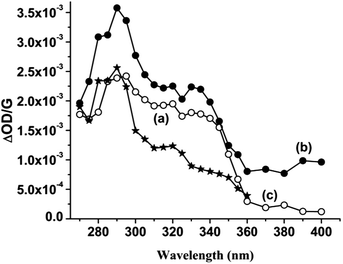 | ||
| Fig. 4 Transient absorption spectra for the reaction of SDBS with (a) ˙OH (b) SO4˙− (c) O˙− at dose of 14 Gy per pulse. | ||
The similar types of transient absorption peaks were observed at 290, 320 and 330 nm in the reaction of SDBS with SO4˙− (Fig. 4b). However, the intensity of the peak at 290 nm significantly increased by 1.5 times in case of SO4˙− as compared to the ˙OH. The SO4˙− is more selective electrophile compared to ˙OH.28 Scheme 1b represents the probable routes of reaction between SO4˙− and SDBS. The SO4˙− does not directly add to the aromatic ring. Instead it produces a very short lived (<0.1μs) radical cation followed by benzyl type radical and hydroxycyclohexadienyl radical by the reactions with water molecules.22,31 SO4˙− can also produce benzyl radical by H-abstraction reaction from the alkyl chain of the SDBS.28,32,33 The bi-molecular rate constants for the reaction of SO4˙− with SDBS was calculated as 3.8 × 108 dm3 mol−1 s−1 from the decay of SO4˙− at 450 nm (at pH 10.0) and it is similar to the value reported ∼3.6 × 108 dm3 mol−1 s−1.28
The H-abstraction reaction of SO4˙− from the alkyl chain was verified by monitoring the decay of SO4˙− radical with the reaction of SDS in N2 purged 5.0 × 10−4 mol dm−3 SDS containing 2.0 × 10−2 mol dm−3 K2S2O8 and 2.0 × 10−2 mol dm−3 tert-butanol at pH 10.0 by employing 14 Gy per pulse. The decay constant of SO4˙− for the reaction with SDS was calculated as 4.7 × 105 s−1 at 440 nm and it was found to be about 1.5 times higher compared to the decay of SO4˙− in a solution containing no SDS (spectra is not shown). It supports that the H-abstraction reaction of SO4˙− from the alkyl chain of SDS and SDBS are of similar nature.
The absorption peaks of the transients formed by the reaction between SDBS and O˙− were also monitored in N2O saturated 5.0 × 10−4 mol dm−3 aqueous SDBS solution at pH 13.5 by applying 14 Gy per pulse (Fig. 4c). The O˙−, being a nucleophilic species cannot add to the benzene ring, rather it is known to react via one electron oxidation producing benzene radical cation followed by benzyl type radicals by the dissociation of Cα-hydrogen.34 Therefore, it showed ΔOD/G features similar to the reaction between SBDS and SO4˙−. The higher peak intensity at 290 nm observed for the reaction between SO4˙− and SDBS is attributed to more favourable formation of benzyl radicals by SO4˙−. Therefore, the higher extent of mineralization of SDBS is not because of the conjugative effect of both ˙OH and SO4˙− radicals, but because of the preferential formation of benzyl type of radicals via the formation of benzene radical cation.
3.5 The influence of the nature of neutralizing acid on the radiolysis of STDWW
The pH of the STDWW solution did not appreciably change even after 50 kGy dose of radiolysis (Fig. 5a) because of the lesser extent of formation of the organic acids from the mineralization of the organic components of STDWW. On the other hand, the pH of the STDWW decreased to 6.3 on irradiating the solution in presence of K2S2O8 for the same dose (Fig. 5b) because of the higher extent of formation of the organic acids from the mineralization of the organic components. The SO4˙− radical efficiently oxidises the organic compounds and itself converts into SO42−, which is a conjugate base of strong acids (HSO4−, H2SO4). Therefore, the pH of the solution significantly decreased during radiolysis in presence of K2S2O8.35 This phenomenon led to the existence of the organic acids in their protonated form and therefore, the rate constants of these acids with SO4˙− decreased which resulted almost negligible extent of mineralization at higher doses than 50 kGy.35 Moreover, the HCO3− ion concentration in equilibrium with CO32− increases with decreasing the pH and it minimizes the scavenging effect as HCO3−.36 However, the minimum COD achieved in the irradiated solution (50 kGy) in presence of K2S2O8 was 1558 ppm, which was much above the permissible discharge limit (≤250 ppm).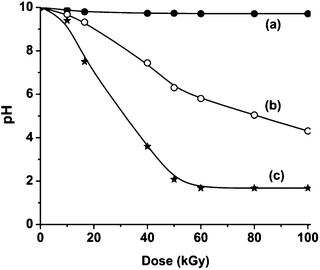 | ||
| Fig. 5 Variation in the pH with different doses after gamma radiolysis of STDWW in the (a) absence and (b) presence of K2S2O8 and (c) STDWW-SA in presence of K2S2O8. | ||
The acetic acid, which was used to adjust the pH of the simulated dye solution, is an organic acid and it contributes significantly in the residual COD of the irradiated solution. Therefore, we did the radiolysis of STDWW in presence of K2S2O8 by replacing the acetic acid (organic acid) by H2SO4 (mineral acid) in the pH adjustment step. The STDWW solution, where the pH was adjusted by diluted H2SO4 will be henceforth designated as STDWW-SA. The initial CODs of the STDWW and STDWW-SA were calculated as 3128 and 1544 ppm, respectively. It could itself give an idea about the contribution of the acetic acid in the total COD of the simulated solution.
Moreover, the extent of mineralization of STDWW-SA increased to 84% upon gamma irradiation for 50 kGy in presence of K2S2O8 and the pH of the solution drastically decreased to ∼2.1. Despite the incomplete mineralization, The COD of STDWW-SA could bring down to 245 ppm (which is below the recommended discharge limit) upon irradiation for ∼60 kGy in presence of K2S2O8. The pH of the irradiated solution was remained constant in the range 1.5–2.0 (Fig. 5c).
4. Conclusions
This study explores a reliable and promising way to use gamma radiolysis in presence of K2S2O8 for efficient mineralization of recalcitrant organics in to CO2 and H2O. Least amount of oxidant was required for gamma radiolysis in presence of K2S2O8 to achieve the same extent of mineralization compared to photocatalysis, ozonolysis and gamma radiolysis in absence of K2S2O8. The higher extent of mineralization of SDBS is not because of the conjugative effect of both ˙OH and SO4˙− radicals, but because of the preferential formation of benzyl type of radicals via the formation of benzene radical cation. To the best of our knowledge, this study reports firstly the calculation of OCC for photocatalysis and gamma radiolysis for comparison with the efficiency of other AOPs. The use of H2SO4 in place of CH3COOH in the pH adjustment step followed by the gamma radiolysis of STDWW in presence of K2S2O8 is recommended for an effective effluent treatment process.Acknowledgements
The authors wish to thank Dr V. Kumar, RTDD, BARC for his kind interest in the work.Notes and references
- I. Arslan, J. Hazard. Mater., 2001, 85, 229–241 CrossRef CAS.
- I. Arslan-Alanton and I. Alaton, Ecotoxicol. Environ. Saf., 2007, 68, 98–107 CrossRef PubMed.
- R. O. Cristovao, A. P. M. Tavares, J. M. Loureiro, R. A. R. Boaventura and E. A. Macedo, Bioresour. Technol., 2009, 100, 6236–6242 CrossRef CAS PubMed.
- J. Riu, I. Schonsee and D. Barcelo, Trends Anal. Chem., 1997, 16, 405–419 CrossRef CAS.
- D. Georgiou, A. Aivazidis, J. Hatiras and K. Gimouhopoulas, Water Res., 2003, 37, 2248–2250 CrossRef CAS.
- A. Pandey, P. Singh and L. Iyengar, Int. Biodeterior. Biodegrad., 2007, 59, 73–84 CrossRef CAS PubMed.
- R. Andreozzi, V. Caprio, A. Insola and R. Marotta, Catal. Today, 1999, 53, 51–59 CrossRef CAS.
- L. Wojnarovits and E. Takacs, Radiat. Phys. Chem., 2008, 77, 225–244 CrossRef CAS PubMed.
- P. H. Chang, Water Sci. Technol., 2004, 49, 213–218 CAS.
- A. Anglada, A. Urtiaga and I. Ortiz, J. Chem. Technol. Biotechnol., 2009, 84, 1747–1755 CrossRef CAS PubMed.
- T. Manson and J. P. Lorimer, Applied Sonochemistry: Uses in Chemistry and Processing, Wiley-VCH, 1st edn, 2002 Search PubMed.
- J. C. Crittenden, R. R. Trussell, D. W. Hand and G. Tchobanglouse, Water treatment principles and design, John Wily and Sons, 2nd edn, 2004 Search PubMed.
- J. Paul, D. B. Naik and S. Sabharwal, Radiat. Phys. Chem., 2010, 79, 770–776 CrossRef CAS PubMed.
- J. Paul, K. P. Rawat, K. S. S. Sarma and S. Sabharwal, Appl. Radiat. Isot., 2011, 69, 982–987 CrossRef CAS PubMed.
- M. Koch, A. Yediler, D. Lienert, G. Insel and A. Ketrupp, Chemosphere, 2002, 46, 109–113 CrossRef CAS.
- G. V. Buxton and C. R. Stuart, J. Chem. Soc., Faraday Trans., 1995, 91, 279–281 RSC.
- U. G. Akapon and B. H. Hameed, J. Hazard. Mater., 2009, 170, 520–529 CrossRef PubMed.
- C. Jiang-Lin, L. Wen-Hua, Z. Jian-Qing and C. Chu-Nan, Acta Phys.-Chim. Sin., 2004, 20, 735–739 Search PubMed.
- B. Kasprzyk-Hordern, M. Ziolek and J. Nawrocki, Appl. Catal., B., 2003, 46, 639–669 CrossRef CAS.
- J. Hoigne and H. Bader, Water Res., 1976, 10, 377–386 CrossRef CAS.
- N. Getoff, Radiat. Phys. Chem., 2002, 65, 437–446 CrossRef CAS.
- J. Paul (Guin), D. B. Naik, Y. K. Bhardwaj and L. Varshney, Radiat. Phys. Chem., 2014, 100, 38–44 CrossRef PubMed.
- R. V. Bensasson, E. J. Land and T. G. Truscott, Flash Photolysis and Pulse Radiolysis, Pergamon Press, Oxford, 1983, pp. 1–19 Search PubMed.
- J. Paul, D. B. Naik and S. Sabharwal, Radiat. Phys. Chem., 2010, 79, 770–776 CrossRef CAS PubMed.
- S. Liang and H.-W. Su, Ind. Eng. Chem. Res., 2009, 48, 5558–5562 CrossRef.
- J. Criquet and N. K. V. Leitner, Chem. Eng. J., 2011, 174, 504–509 CrossRef CAS PubMed.
- P. Canizares, R. Paz, C. Saez and M. A. Radrigo, J. Environ. Manage., 2009, 90, 410–420 CrossRef CAS PubMed.
- J. Mendez-Diaz, M. Sanchez-Polo, J. Rivera-Utrilla, S. Canonica and U. V. Gunten, Chem. Eng. J., 2010, 163, 300–306 CrossRef CAS PubMed.
- L. Osiewala, A. Socha, M. Wolszczak and J. Rynkowski, Radiat. Phys. Chem., 2013, 87, 71–81 CrossRef CAS PubMed.
- S. M. Dockheer, L. Gubler and W. H. Koppenol, Phys. Chem. Chem. Phys., 2013, 15, 4975–4983 RSC.
- P. Neta, V. Madhavan, H. Zemel and R. W. Fessenden, J. Am. Chem. Soc., 1977, 99, 163–164 CrossRef CAS.
- L. Osiewala, A. Socha, M. Wolszczak and J. Rynkowski, Radiat. Phys. Chem., 2013, 87, 71–81 CrossRef CAS PubMed.
- H. Zemel and R. W. Fessenden, J. Phys. Chem., 1978, 82, 2670–2676 CrossRef CAS.
- S. Venu, D. B. Naik, S. K. Sarkar, U. K. Aravind, A. Nijamudheen and C. T. Aravindakumar, J. Phys. Chem. A, 2013, 117, 291–299 CrossRef CAS PubMed.
- J. Criquet and N. K. V. Leitner, Chemosphere, 2009, 77, 194–200 CrossRef CAS PubMed.
- I. Grcic, S. Papic, N. Koprivanak and I. Kovacic, Water Res., 2012, 46, 5683–5695 CrossRef CAS PubMed.
| This journal is © The Royal Society of Chemistry 2014 |

